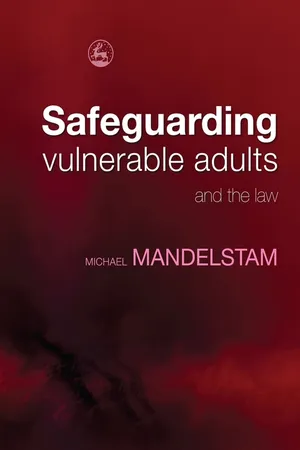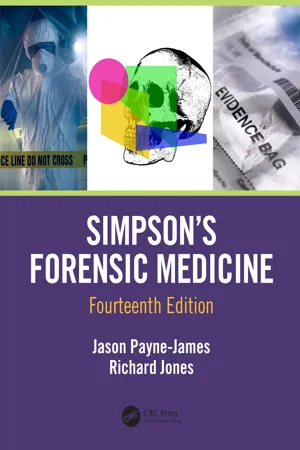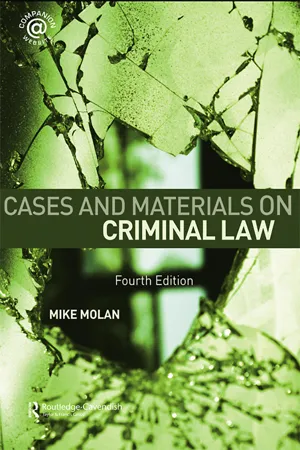Law
Grievious Bodily Harm (GBH)
Grievous Bodily Harm (GBH) refers to a serious physical injury inflicted intentionally or recklessly upon another person. It is a criminal offense and can result in severe legal consequences. GBH can include injuries such as broken bones, internal organ damage, or disfigurement, and the severity of the harm is a key factor in determining the level of criminal liability.
Written by Perlego with AI-assistance
Related key terms
6 Key excerpts on "Grievious Bodily Harm (GBH)"
- eBook - ePub
- Tony Storey, Alan Lidbury(Authors)
- 2012(Publication Date)
- Willan(Publisher)
Ireland).- Wounding means that the continuity of the skin must be broken (Moriarty v Brookes). Purely internal bleeding is not a ‘wound’ (JCC [a minor] v Eisenhower).
- GBH means really serious harm (DPP v Smith [1961]) or just serious harm (Saunders). It includes psychiatric injury (Burstow) but psychological harm does not suffice (Dhaliwal). The transmission of a serious disease through sexual intercourse can lead to liability for inflicting ‘biological’ GBH (Dica; Konzani).
- There is no practical distinction between ‘inflicting’ GBH and ‘causing’ GBH (Burstow).
- The word ‘maliciously’ in s.20 and s.18 means intentionally or recklessly.
- The subjective Cunningham test for recklessness applies to all non-fatal offences (Savage; DPP v Parmenter), including those that do not expressly require ‘malice’ (Venna).
- In s.47 it is sufficient mens rea that D foresees that their acts might result in force being applied to V, or that V is made apprehensive of force being applied to them. D does not have to have foreseen the degree of harm required for the actus reus, i.e. ABH (Roberts; Savage).
- In s.20 it is sufficient mens rea that D foresees that their acts might cause ‘some harm to some other person’. D does not need to have foreseen the degree of harm required for the actus reus, i.e. wounding or GBH (Mowatt; Savage).
- The draft Offences Against the Person Bill (1998) would abolish all of the above offences and replace them with four new offences: assault, intentional or reckless injury, reckless serious injury and intentional serious injury. ‘Injury’ would include physical or mental injury.
Passage contains an image
9 Consent
DOI: 10.4324/9780203722992-12Introduction
One thing that should become apparent upon reading this chapter is that the availability of the defence of consent has attracted a good deal of public debate in recent years. This is because consent often involves balancing the freedom of the individual against considerations of public policy as interpreted by the courts. - eBook - ePub
- Mary Charman, Bobby Vanstone, Liz Sherratt(Authors)
- 2012(Publication Date)
- Willan(Publisher)
In fact, although the legal boundaries of wounds leading to grievous bodily harm are unclear, there are guidelines for the police in the 1994 charging standards. The level of wounding expected to lead to a charge of grievous bodily harm includes:- injury resulting in permanent disability;
- permanent loss of any sensory function;
- significant permanent visible disfigurement;
- broken or displaced limbs or bones (including fractured skull, compound fractures, broken cheek bone, jaw, ribs etc.);
- injuries causing substantial loss of blood, usually requiring a transfusion; and
- injuries (physical or psychiatric) resulting in lengthy treatment or incapacity.
C (a minor) v Eisenhower (1984)A child who was shot by an air gun, the pellet rupturing a blood vessel in the eye and causing internal bleeding. Since the victim suffered internal injuries but no breaking of the skin, this did not amount to an offence under this statutory provision.Section 18 uses the word ‘cause’ and Section 20 uses the work ‘inflict’. Until recently the word ‘cause’ was thought to be wider (and therefore easier to prove) than ‘inflict’. However, in 1997 the House of Lords decided unanimously that there was no difference between the two words.R v Burstow (1997)The defendant was charged with inflicting grievous bodily harm when he caused his victim psychiatric harm by stalking her. He sent her hate mail, made malicious telephone calls, stole garments from her washing line and passed around intimate personal details about her family. The question arose as to whether Burstow had ‘inflicted’ the harm. It was held that there was no need to prove a direct use of force. Lord Hope said, ‘For all practical purposes … the words ‘cause’ and ‘inflict’ may be taken to be interchangeable.’Section 20
The mens rea for the offence generally known as malicious wounding under Section 20 is based on the word ‘maliciously’. Malice in this context does not necessarily mean the same as the old idea of evil or wicked, but it was said in Cunningham that in this context ‘maliciously’ meant intentionally or recklessly (remember the Cunningham - eBook - ePub
- Michael Mandelstam(Author)
- 2008(Publication Date)
- Jessica Kingsley Publishers(Publisher)
There does, however, have to be evidence of intention or recklessness for the offence to be committed. Thus, when three carers were accused of assault, by pouring talcum power into the mouth of an 87-year-old care home resident, they were acquitted. Whilst the district judge noted that the care had been below standard, and two of the carers admitted using unnecessary force when washing and handling the woman, nonetheless he could not be sure beyond reasonable doubt of intention or recklessness (Dayani 2004).8.1.1.1 Other offences going beyond common assaultThere are more serious offences. Assault occasioning bodily harm under s.47 of the Offences Against the Person Act 1861 carries a maximum of five years’ imprisonment. This offence is distinguished from common assault by the degree of injury resulting. For instance, common assault might typically concern grazes, scratches, abrasions, minor bruising, swellings, reddening of the skin, superficial cuts, or a black eye. Whereas actual bodily arm could include loss or breaking of a tooth or teeth, temporary loss of sensory functions including consciousness, extensive or multiple bruising, displaced or broken nose, minor fractures, minor but not superficial cuts, psychiatric injury beyond fear, distress or panic.Unlawful wounding or infliction of grievous bodily harm comes under s.20 of the Offences Against the Person Act 1861, carrying a maximum of five years’ imprisonment. Wounding would cover more serious cuts or lacerations, as opposed to more minor ones. Grievous bodily harm is serious bodily harm including, for example, injury resulting in permanent disability or permanent loss of sensory function, more than minor, permanent, visible disfigurement, broken bones, compound fractures, substantial loss of blood, injuries resulting in lengthy treatment or incapacity, psychiatric injury.Section 18 of the Act contains a similar offence but there must also be intent to cause wounding or grievous bodily harm (CPS/1).8.2 FALSE IMPRISONMENTFalse imprisonment is a common law offence involving the unlawful and intentional or reckless detention of a person:False imprisonment and death in a shed of vulnerable adult at the hands of those who has befriended him. A vulnerable and epileptic man died, after being kept in a shed for a period of four months by three people who had befriended him. He was found dead with extensive bruising and burn marks. The prosecution could not prove that death was not due to his epilepsy; the three defendants were jailed for some ten years each for assault, causing actual bodily harm and false imprisonment (de Bruxelles 2007a). However, a subsequent coroner’s hearing concluded that he had been unlawfully killed, almost certainly due to a loss of blood (Metro Newspaper - eBook - ePub
- Jason Payne-James, Richard Martin Jones, Jason Payne-James, Richard Martin Jones(Authors)
- 2019(Publication Date)
- CRC Press(Publisher)
In the England & Wales jurisdiction a ‘wound’ (used in the colloquial setting interchangeably with ‘injury’) has a specific legal meaning: a wound is an injury that breaks the continuity of the skin. There must be a division of the whole skin structure and not merely a division of the cuticle or upper layer. A bruise (or subcutaneous rupture of blood vessels) is not a wound as the skin is not broken. A broken bone is not (legally) a wound, unless it is a comminuted fracture.The Offences Against the Person Act 1861 which has been amended over the years, sets out a range of offences for which an individual, in England & Wales, can be prosecuted when that individual is alleged to have caused injury to another person. This statute excludes homicide and sexual offences (which are covered by the Sexual Offences Act 2003).The language used in a law whose origins go back almost one and half centuries can sometimes be difficult to understand. The main offences relevant to injury assessment by forensic practitioners are found in the following sections of the Offences Against the Person Act 1861.Section 18Section 18 of the Offences Against the Person Act 1861 created the offences of wounding and causing grievous bodily harm, with intent to cause grievous bodily harm, or to resist arrest. It is punishable with life imprisonment. The specific wording of the offence is:Whosoever shall unlawfully and maliciously by any means whatsoever wound or cause any grievous bodily harm to any person … with intent … to do some … grievous bodily harm to any person, or with intent to resist or prevent the lawful apprehension or detainer of any person, shall be guilty of felony, and being convicted thereof shall be liable … to be kept in penal servitude for life … .The key element of this offence is the intent to cause grievous bodily harm. Types of injury would include stabbings or shootings, but may also include trying to poison or infect a person. Section 20This section creates the offences of wounding and inflicting grievous bodily harm. They are less serious than the offences created by Section 18 and carry a maximum prison sentence of 5 years. The key element of this offence is the causing of grievous bodily harm or wounding but without having had the intent to do so.Section 47This section of the Act creates the offence of assault occasioning actual bodily harm. It encompasses those assaults that result in substantial injuries, typically requiring a degree of medical treatment for the victim and provides the penalty to which a person is liable on conviction of that offence on indictment. A periorbital haematoma with a superficial laceration after a punch, or a broken tooth, are the types of injury that could be considered a Section 47 assault. - eBook - ePub
Cases & Materials on Criminal Law
Fourth Edition
- Mike Molan(Author)
- 2009(Publication Date)
- Routledge-Cavendish(Publisher)
My Lords, I have had the advantage of reading in draft the speeches of your Lordships. I agree with the reasoning and conclusions of my noble and learned friends, Lord Templeman and Lord Jauncey of Tullichettle, and I, too, would answer the certified question in the negative and dismiss the appeals.In stating my own further reasons for this view I shall address myself exclusively to the cases in which, as has been informally agreed, one person has acted upon another in private, occasioning him actual bodily harm but nothing worse …… Everyone agrees that consent remains a complete defence to a charge of common assault and nearly everyone agrees that consent of the victim is not a defence to a charge of inflicting really serious personal injury (or ‘grievous bodily harm’). The disagreement concerns offences which occasion actual bodily harm: the appellants contend that the consent of the victim is a defence to one charged with such an offence, while the respondent submits that consent is not a defence. I agree with the respondent’s contention for reasons which I now explain …I suggest that the following points should be noted…- Wounding is associated in ss 18 and 20 with the infliction of grievous bodily harm and is naturally thought of as a serious offence, but it may involve anything from a minor breaking or puncture of the skin to a near fatal injury. Thus wounding may simply occasion actual bodily harm or it may inflict grievous bodily harm. If the victim’s consent is a defence to occasioning actual bodily harm, then, so far as concerns the proof of guilt, the line is drawn, as my noble and learned friend Lord Jauncey of Tullichettle puts it … ‘somewhere down the middle of s 20’, which I would regard as a most unlikely solution.
- eBook - ePub
- Rodger Geary(Author)
- 2012(Publication Date)
- Routledge-Cavendish(Publisher)
Section 20 of the Offences Against the Person Act 1861 creates two offences of ‘... malicious wounding’ and ‘... maliciously inflicting grievous bodily harm’.Actus ReusA wounding requires a complete break of all the layers of the victim’s skin (JCC v Eisenhower (1984)). According to the House of Lords, grievous bodily harm means ‘really serious harm’ (DPP v Smith (1961)), although the Court of Appeal has indicated that it is sufficient for a trial judge to direct a jury that grievous bodily harm simply means ‘serious harm’ (R v Saunders (1985)). On a charge of murder, when directing the jury as to the degree of bodily harm intended, it is for the judge to decide in each case whether it is necessary to use the word ‘really’ before the words ‘serious bodily harm’ (R v Janjua; R v Choudhury (1998)).Although most offences under s 20 will involve an assault, it was decided in R v Wilson (1983) that ‘inflicting’ does not necessarily imply an assault. It has therefore been suggested that if ‘inflicting’ was to have any meaning at all, it had to imply the need for causation. However, in Burstow and Ireland (1997), the House of Lords confirmed that ‘inflicting’ did not imply an assault or the violent application of force to the body, but held that ‘cause’ and ‘inflict’ are not synonymous although there is no ‘radical divergence’ of meaning. Lord Hope stated that ‘... the word “inflict” implies that the consequence of the act is something which the victim is likely to find unpleasant or harmful’. Surely, this approach must be misconceived. After all, what about Brown and Others
Learn about this page
Index pages curate the most relevant extracts from our library of academic textbooks. They’ve been created using an in-house natural language model (NLM), each adding context and meaning to key research topics.





